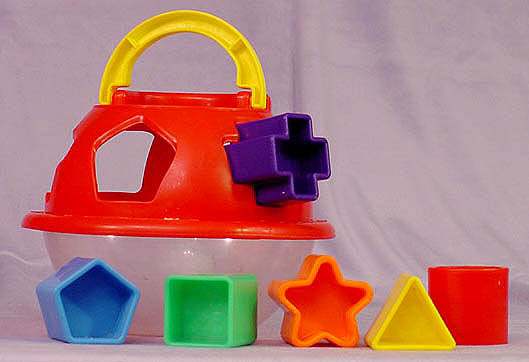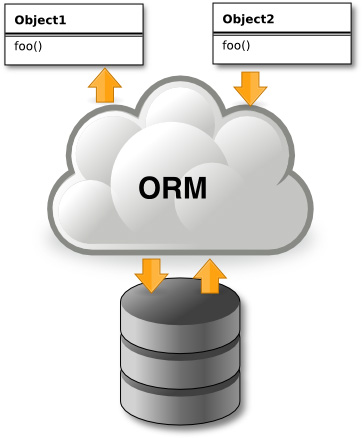CSC/ECE 517 Fall 2009/wiki3 12 obj to relational: Difference between revisions
| Line 5: | Line 5: | ||
[[Image:Fp1059-shape-ball.JPG |thumb]] [10] | [[Image:Fp1059-shape-ball.JPG |thumb]] [10] | ||
Object-orientation and relational model are different paradigms of programming.[1] The object paradigm is based on building applications out of objects that have both data and behavior, | Object-orientation and relational model are different paradigms of programming.[1] The object paradigm is based on building applications out of objects that have both data and behavior, whereas the relational paradigm is based on storing data. With the object paradigm, one traverses objects via their relationships whereas with the relational paradigm one duplicates data to join the rows in tables.[2] The difference between how object models work and relational databases is known as the “Object-Relational Impedance Mismatch”. This is just nerd-speak for “they are different”. In analogy, we could consider the example of the ball and shape game. It's the same thing; you can’t fit a square in a triangle hole.[10] | ||
whereas the relational paradigm is based on storing data. With the object paradigm, one traverses objects via their relationships whereas with the relational paradigm one duplicates data to join the rows in tables.[2] The difference between how object models work and relational databases is known as the “Object-Relational Impedance Mismatch”. This is just nerd-speak for “they are different”. In analogy, we could consider the example of the ball and shape game. It's the same thing; you can’t fit a square in a triangle hole.[10] | |||
One way to avoid the impedance mismatch between objects and relations is to use an object-oriented | One way to avoid the impedance mismatch between objects and relations is to use an object-oriented | ||
database. However, systems often need to store objects in a relational database. Sometimes a system needs | database. However, systems often need to store objects in a relational database. Sometimes a system needs | ||
relational calculus or the maturity of a relational database. Other times the corporate policy is to use a relational database rather than an object-oriented database. Whatever the reason, a system that stores | relational calculus or the maturity of a relational database. Other times the corporate policy is to use a relational database rather than an object-oriented database. Whatever the reason, a system that stores | ||
objects in a relational database needs to provide a design that reduces the impedance mismatch | objects in a relational database needs to provide a design that reduces the impedance mismatch.[5] One of the secrets of success for mapping objects to relational databases is to understand both paradigms, and their differences, and then make intelligent trade offs based on that knowledge.[2] An application that maps between the two paradigms needs to be designed with respect to performance, maintainability and cost to name just a few requirements.[4] | ||
One of the secrets of success for mapping | |||
objects to relational databases is to understand both paradigms, and their differences, and then make | |||
intelligent | |||
that maps between the two paradigms needs to be designed with respect to performance, | |||
maintainability and cost to name just a few requirements | |||
Revision as of 00:00, 18 November 2009
Patterns for mapping objects to relational databases
The Object-Relational Mismatch

[10]
Object-orientation and relational model are different paradigms of programming.[1] The object paradigm is based on building applications out of objects that have both data and behavior, whereas the relational paradigm is based on storing data. With the object paradigm, one traverses objects via their relationships whereas with the relational paradigm one duplicates data to join the rows in tables.[2] The difference between how object models work and relational databases is known as the “Object-Relational Impedance Mismatch”. This is just nerd-speak for “they are different”. In analogy, we could consider the example of the ball and shape game. It's the same thing; you can’t fit a square in a triangle hole.[10]
One way to avoid the impedance mismatch between objects and relations is to use an object-oriented database. However, systems often need to store objects in a relational database. Sometimes a system needs relational calculus or the maturity of a relational database. Other times the corporate policy is to use a relational database rather than an object-oriented database. Whatever the reason, a system that stores objects in a relational database needs to provide a design that reduces the impedance mismatch.[5] One of the secrets of success for mapping objects to relational databases is to understand both paradigms, and their differences, and then make intelligent trade offs based on that knowledge.[2] An application that maps between the two paradigms needs to be designed with respect to performance, maintainability and cost to name just a few requirements.[4]
Concurrency Patterns
Read/Write Access Pattern
Conclusion
The concurrency patterns discussed above involve coordinating concurrent operations. They address two types of problems:[5]
Shared resources - When concurrent operations access the same data or another type of shared resource, operations may interfere with each other if they access the resource at the same time. To ensure that operations on shared resources execute correctly, the operations must be sufficiently constrained to access their shared resource one at a time. However, if the operations are overly constrained, then they may deadlock and not be able to finish executing.
Sequence of operations - If operations are constrained to access a shared resource one at a time, it may be necessary to ensure that they access the shared resource in a particular order. For example, an object cannot be removed from a data structure before it is added to the data structure.
See Also
- Monitor Object
- Active Object
- Thread pool pattern
- Reactor patter
- Double Buffering
- Scheduler
- Asynchronous Processing
References
[1] Wolfgang Keller, Mapping Objects to Tables - A Pattern Language http://www.objectarchitects.de/ObjectArchitects/papers/Published/ZippedPapers/mappings04.pdf
[2] Scott W. Ambler, President, Ronin International, Mapping Objects To Relational Databases http://www.crionics.com/products/opensource/faq/docs/mappingObjects.pdf
[3] Scott W. Ambler, Mapping Objects to Relational Databases: O/R Mapping In Detail http://www.agiledata.org/essays/mappingObjects.html
[4] Wolfgang Keller, Object/Relational Access Layers - A Roadmap, Missing Links and More Patterns http://citeseer.ist.psu.edu/4328.html
[5] Joseph W. Yoder, Ralph E. Johnson, Quince D. Wilson, Connecting Business Objects to Relational Databases http://citeseerx.ist.psu.edu/viewdoc/download?doi=10.1.1.34.7703&rep=rep1&type=pdf
[6] Michael R. Blaha, William J. Premerlani and James E. Rumbaugh, Relational Database Design using an Object-Oriented Methodology http://www.sims.monash.edu.au/subjects/ims2501/seminars/oomodelling.pdf
[7] http://www.cetus-links.org/oo_db_systems_3.html
[8] http://www.ibm.com/developerworks/library/ws-mapping-to-rdb/
[10] http://cantgrokwontgrok.blogspot.com/2009/03/tech-day-1-nhibernate.html
[11] http://www.adobe.com/newsletters/edge/october2008/articles/article2/index.html?trackingid=DWZST
